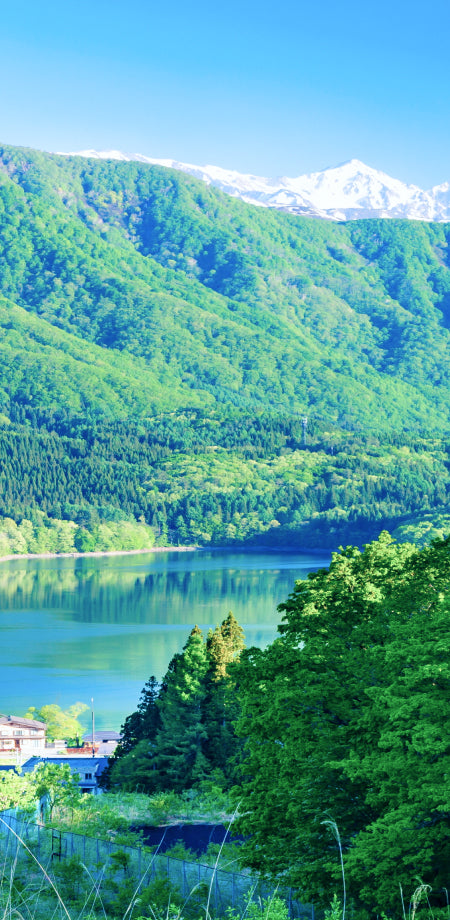投稿日:
更新日:
The highest mushroom production in Japan! I want to eat it in the summer, it's delicious in the summer Nagano The prefecture's speciality
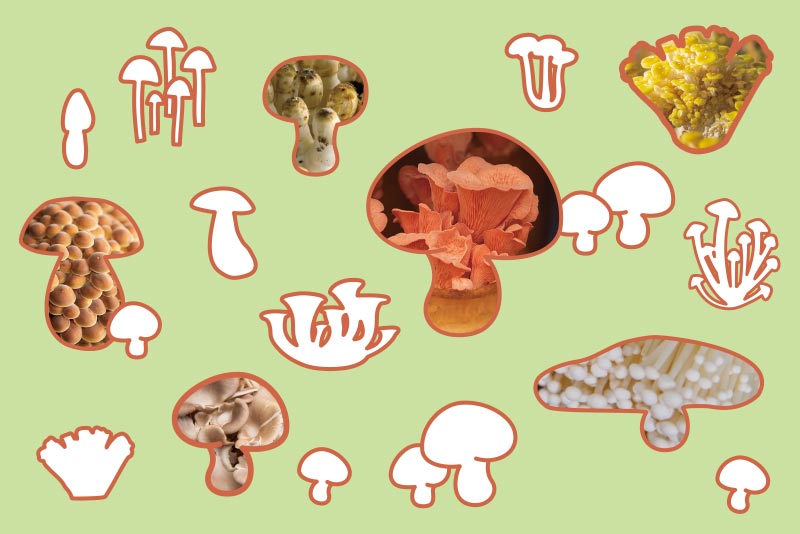
Mushrooms are said to have over 60,000 varieties all over the world. Did you know that there are 4,000 to 5,000 species in Japan, and about 300 of them are edible? Mushrooms are often thought to be an autumnal ingredient, but in nature, a variety of mushrooms grow throughout the year. Mushrooms are rich in dietary fiber that regulates the intestinal environment and vitamin B1 that supports the creation of energy from carbohydrates, and are actually a food your body needs in the summer. Boasting the highest production volume in Japan Nagano We visited the production sites in the prefecture where unique initiatives are being carried out with particular attention to the growing environment and we explored the secrets and charms of mushrooms.
A rich mountain mushroom grown in the great outdoors
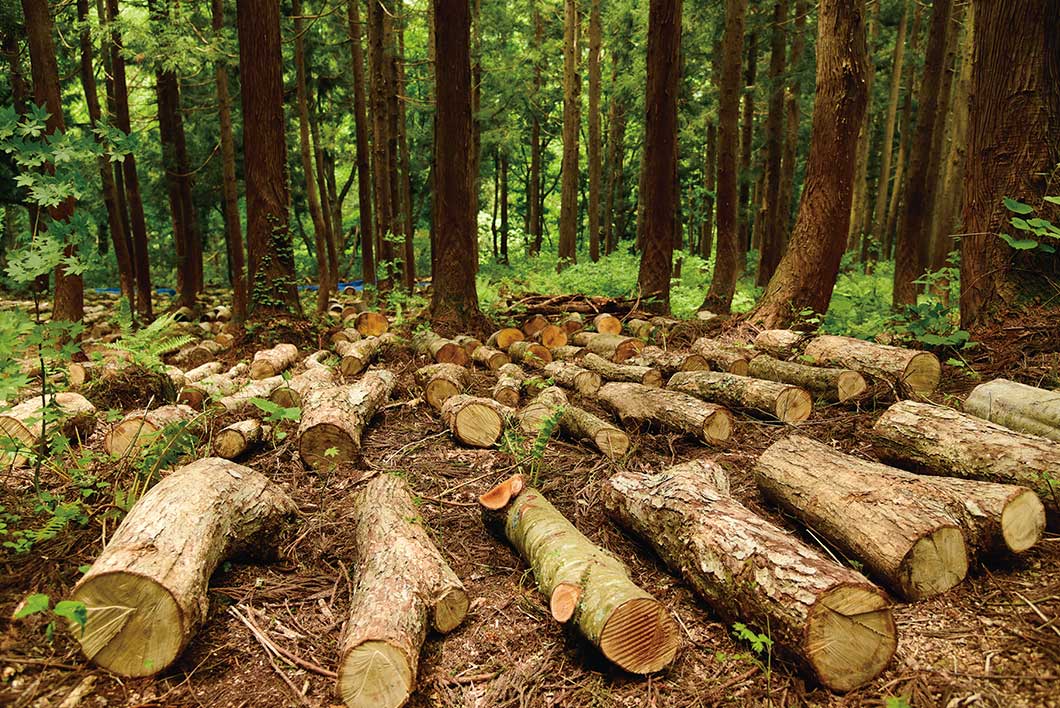
Marunaka Lodge(Nozawa Onsen Village)
As you walk along a mountain path with only one car passing by, you will see an area lined with multiple logs on the mountainside. The log features a large mushroom that can be seen from a distance. Marunaka Lodge is a place where logs grow in the mountains of Nozawa Onsen Village. About 20 years ago, the hotel was renovated from a guesthouse to an experiential lodge, and the owner himself guides the guests to harvest mushrooms and wild vegetables, allowing them to enjoy the mountains, making it a "mushroom inn" that only a few people visit, and is known to only a few fans.
"The flavor and flavor of mushrooms in the mountains are completely different. The distinctive seasons of Nozawa Onsen Village nurture delicious mushrooms."
This is what the owner Kadowaki Akihiko said. The mushrooms grown in an environment that is as close as they are natural mushrooms as they are, are surprisingly large, and some such as maitake mushrooms grow to a size that cannot fit into cardboard boxes.
Kadowaki grows about 10 types of mushrooms throughout the year, including the growing logs of Nameko, the spring shiitake mushrooms in the middle of May, when the snow melts, the summer shiitake mushrooms, the autumn shiitake mushrooms, nameko and autumn shiitake mushrooms, and finally the "winter mushrooms" Enokitake mushrooms, which are also known as "winter mushrooms." It takes about two years from the time the mushroom fungus is implanted into a log to the time it is harvested, but the compatibility between the fungus and the log is important, and Kadowaki says that he chooses bacteria when he sees the tree.
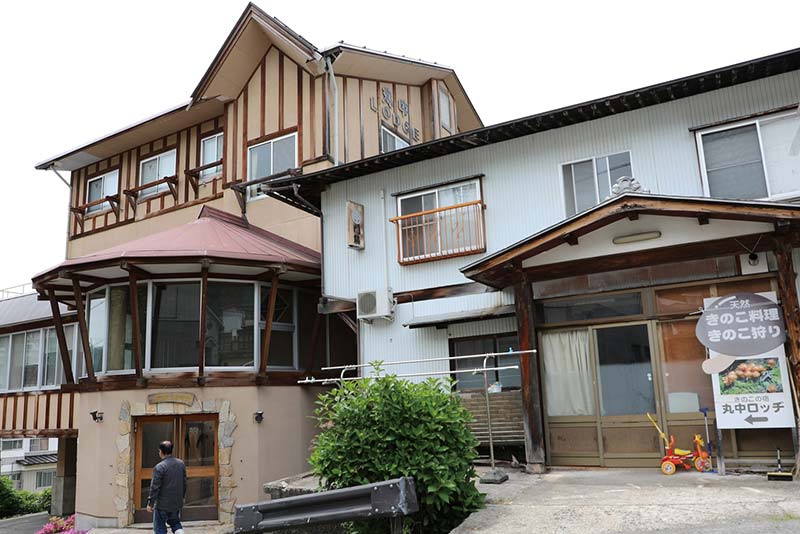
Also, when it's time for harvest, I visit the mountains every day to determine the timing so that they can be harvested at the best time. Maitake, who has a strong image of grey-brown, says Kadowaki, "When it changes from a dark color to a light brown, it's the perfect time to eat and it's super tasty." Despite repeated mistakes, many years of experience cultivated will nurture the finest mushrooms.
"Mushrooms have the role of converting mountain trees to soil. That's why mushroom-making is also about circulating the bounty of the mountain and protecting the mountain," says Kadowaki.
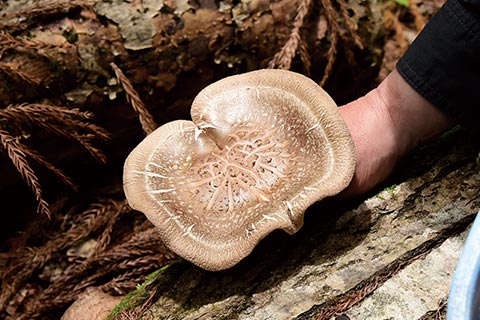
The log mushrooms grown in a natural environment are very large, and the shiitake mushrooms are as large as the palm of an adult's hand. Many people are surprised by the size, firm texture and flavor that they have never seen before.
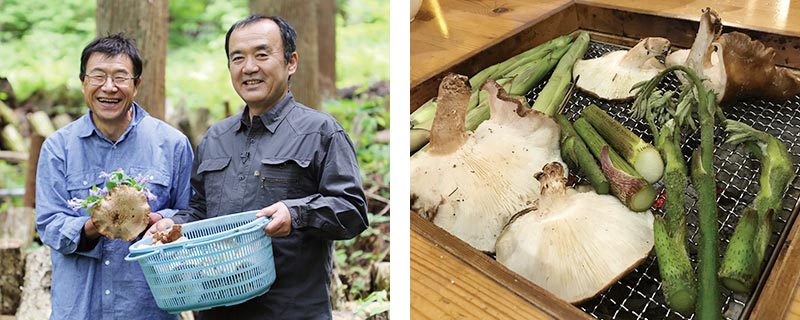
A mushroom dish that is enjoyed through extremely simple cooking, featuring the famous Marunaka Lodge, making use of the flavor of the ingredients. "The mushrooms and wild vegetables, which are rich in minerals and grown by the black soil moistened by the melted snow water, have a different taste," says Kadowaki (right of the photo). He is also very close to Kitazawa Masakazu (photo left) from the Artisankan, and Kitazawa praises him, saying, "Not only wild vegetables, but also natural herbs like Kuromoji and birch sap that is rich in the bounty of the earth. Kadowaki's mushrooms are also one of those treasures."
[Marunaka Lodge]
4424-2 Toyogo, Nozawa Onsen Village, Shimotakai District TEL 0269-85-2157
"Mushrooms are tree-child" Enokitake grows with the blessings of the forest
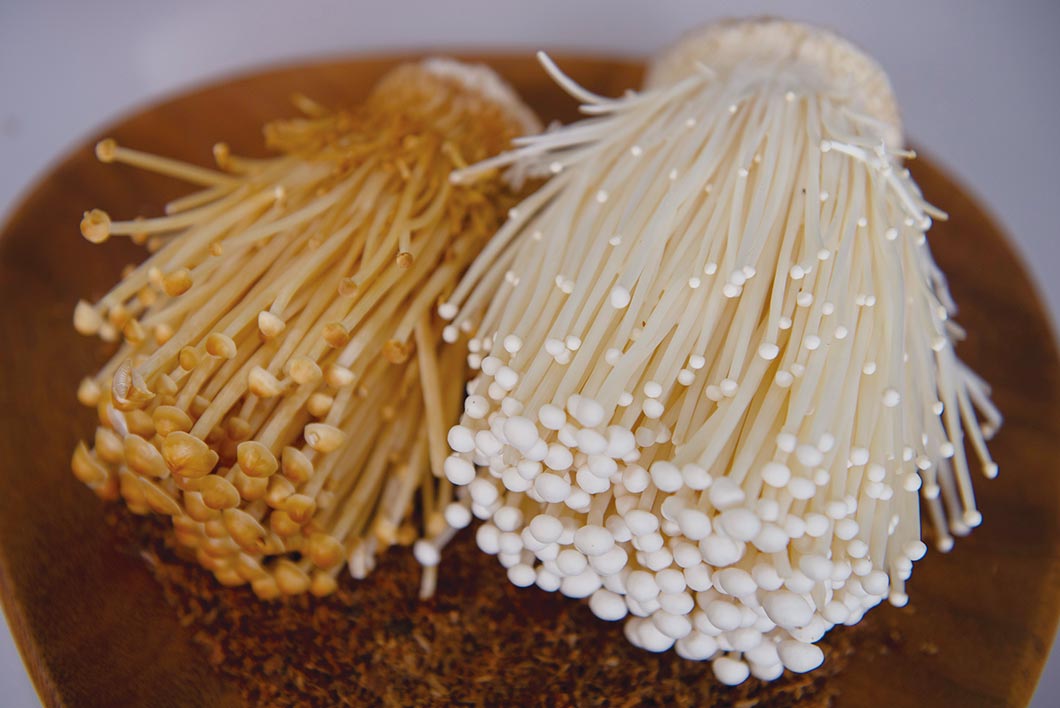
Marugane Co., Ltd.(Nagano City)
Nagano Enokitake is a region that produces more than 60% of the national distribution volume. In the past, medium made from gae flour (wooden flour) (a bed of bacteria in which mushrooms grow) was used, but in recent years, medium made from crushed inexpensive foreign corn mobs (corn cores) that can greatly increase yields have become the norm. Meanwhile, we still produce culture medium that has been crushed from domestically produced materials and aged for 1-2 years.Nagano City"Marukin" of. As many producers change their cultivation methods in pursuit of lower prices and efficiency, the company, whose mission is to contribute to the health and happiness of people and the planet through Enokitake, has been using unchanging manufacturing methods since 1972, when Enokitake began producing Enokitake.
"As it is said that mushrooms are "tree-cups," trees grow in nature from forest stumps and fallen trees, and cannot photosynthese the trees. Therefore, our company is particular about "tree-cups (wooden flour)" and continues to grow them in the traditional way, pursuing the natural environment and deliciousness of natural mushrooms."
This is what the executive director Kaneko Keisuke said. The kitake, which contains the blessings of the forest, has a sweet aroma, thick, firm stems, and a crunchy texture, and is rich in flavor. The stewed stew is also yellow in the corn mob, but the company's products are clear, so the dishes do not interfere with the color of other ingredients. Furthermore, since the use of thinned domestic wood to make gae flour, and the ingredients used are clear, it is also used in ingredients in Michelin-starred restaurants and high-end inns that are particular about safety and security and the environment, as well as natural vegan restaurants.
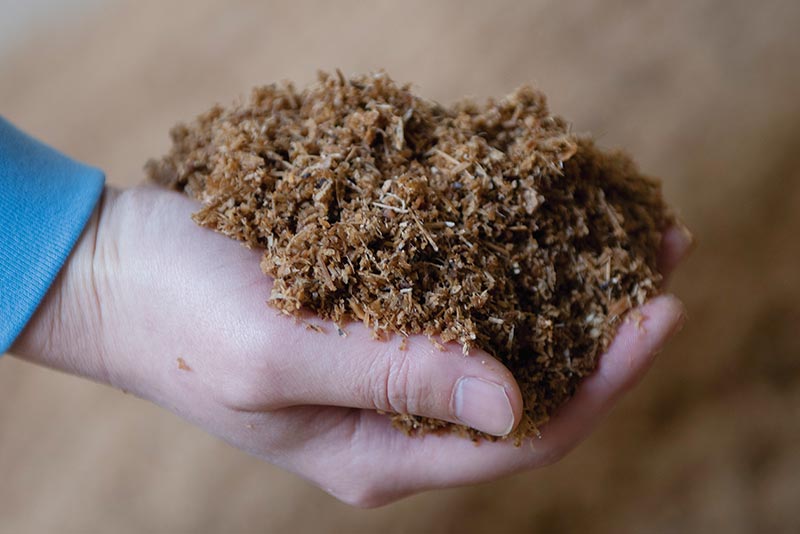
The cultivation room is also set to the same temperature, humidity and brightness as the harsh natural environment, with the aim of creating an environment where natural enogiri grows. The water that has been preparedNagano CityIt uses natural spring water from Togakushi.
Furthermore, the culture medium after harvesting Enokitake is 100% effective. Because it is a woody medium, mushroom bacteria are active even after harvesting, and when it is aged for about a year and then poured into the field, the hyphae remaining in the medium decomposes organic matter and brings out the power of the soil, which is why farmers who use organic pesticide-free vegetables have been asked. We donate soil to apple farmers affected by the East Japan Typhoon in 2019. Through these efforts,Shinshu"Happiness" with the theme of "Healthy Longevity and Security" from the Brand Awards 2019ShinshuHe won the grand prize in the category. The company's awareness has surpassed the food industry and is also expanding as a sustainable business model.
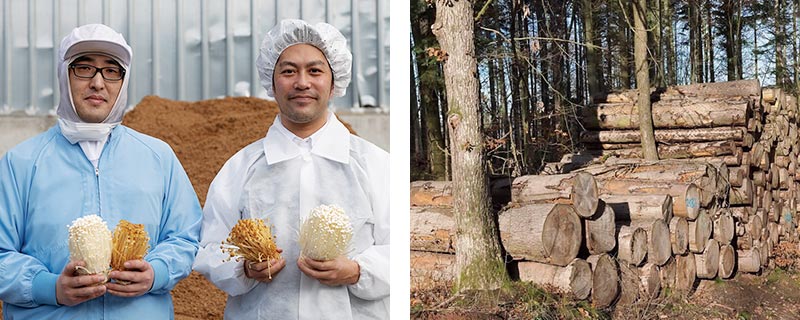
The domestically produced timber used for the culture medium is thinned for about 30 years. "By making effective use of thinned wood to develop forest soil and creating planted soil in the forest, we are bringing the special bounty of the forest to many people in the town," says Kaneko (right of the photo).
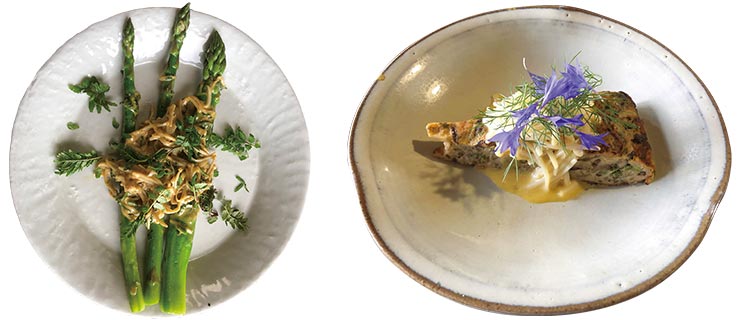
"We tend to imagine hot pot dishes when it comes to Enokitake, but in the future we will be introducing a variety of Enokitake recipes on our website to show you how they go with a variety of dishes regardless of season or genre," says Kaneko.
Photographed by Spanish omelette with Enoki mushrooms and Enoki mushrooms with Enoki mushrooms (made by Kitazawa Masakazu)
[Marugane Co., Ltd.]
Nagano CityShinonoi Komatsubara 2367-1 TEL 026-293-2177
https://www.marukin.jp/
INFORMATION
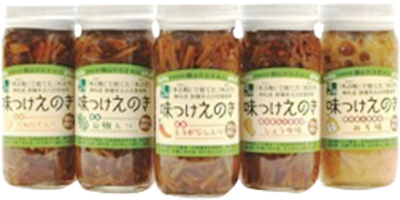
Ginza NAGANO Some are on sale at
In addition to the main pure white Enokitake, we also cultivated Enokitake, a brown native species that is closer to its natural state. Ginza NAGANO Product development is also being performed by Yokoyama Takako, who is also well known as an event instructor.
It's like hors d'oeuvres! Rare mushrooms produced in-house
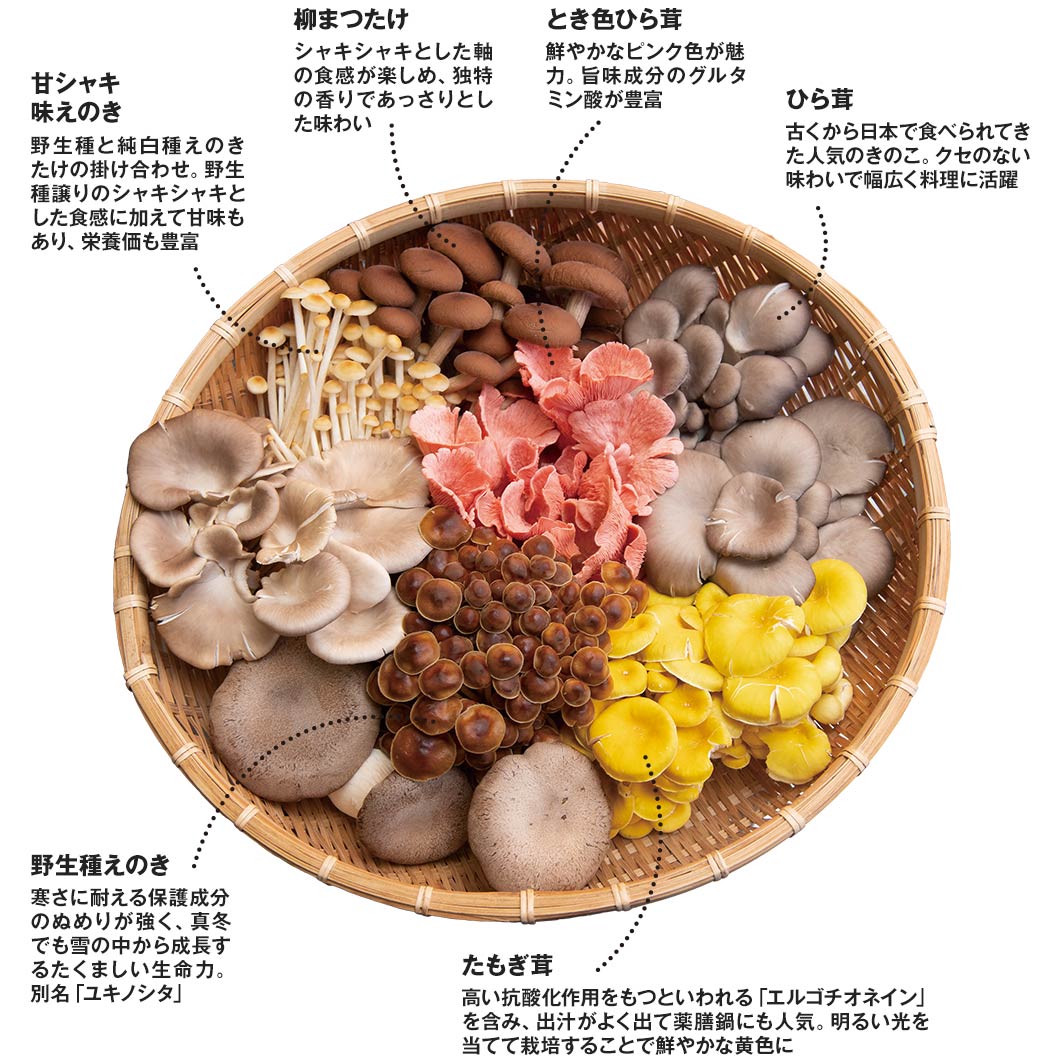
Mushroom Village(Suzaka City)
Mushroom Village is located in a mountain village rich in nature at the foot of Sugadaira Plateau. We carry out everything from growing and cultivating our own in-house production to cultivating and processing.
"It is only by growing the seed bacteria and doing it in-house that we can focus on the detailed cultivation specifications," says Arai Masahiro, head of the Mushroom Village Division of Shinko Kogyo Co., Ltd. The company, which was responsible for designing and constructing plants (a set of factory equipment) for Motoko Tokinoko farmers, began to enter mushroom cultivation more than 30 years ago. Currently, we grow a variety of mushrooms that are difficult to mass-produce and are rare and valuable.
The six types of mushrooms are constantly grown: tamogi mushrooms, sweet and crispy flavored enoki mushrooms, wild seed enoki mushrooms, tokiiro hira mushrooms, hira mushrooms, and yanagi mushrooms. "Tamogi mushrooms," "Tokiirohira mushrooms," and "Hiratsuki mushrooms" grow from early summer to autumn, while Enokitake mushrooms are mushrooms that grow from autumn to winter. The cultivation environment is adjusted by changing the temperature, humidity, and light of the cultivation room according to each type, and some equipment such as a sterilizing pot are manufactured in-house. All of the mushrooms made in this way are rich in flavor and nutritional value. In addition, "wild species of Enokitake" is a species of Enokitake, a native species that grew naturally in the mountains and is cultivated. They have been breeding a common pure white berry roe kitake to create a "sweet crunchy roe" varieties, creating new varieties.
Even when cultivating, Tokiiro Hiramushrooms are particularly difficult to manage. It is a native species that grows wild in the fields and mountains of Japan from early summer to autumn, but is delicate and susceptible to withering, and there are only 4-5 farmers in Japan. Their charm is their beautiful pink colour, and they are used in dishes that add color tones, both Japanese and Western, and are often used in wedding dishes.
"We received the seed bacteria from a producer outside the prefecture that stopped cultivating, but after a series of hardships, we quickly understood why other companies stopped. After trial and error, we are finally able to make them steadily, but each mushroom has a different personality, so there are still some things we don't know about, and as we grow them every year, we always make new discoveries."
Japan has put a lot of effort and passion into dealing with so many rare species. That's why it's highly praised by chefs. It's not easy to continue growing six types of mushrooms without waste. Still, Arai's enthusiasm, "We need to make it for the chefs who want us," is driving him.
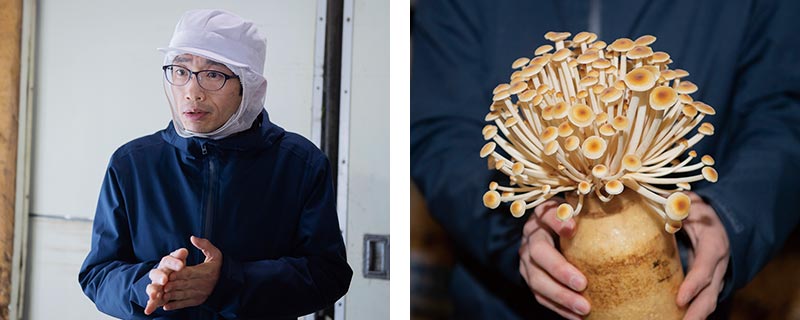
"When we consider the deliciousness and health of the people who eat it, the best thing to do is to grow mushrooms energetically without putting stress on them. To do this, we grow them freely and freely as they want to grow," says Arai. We also do not use the usual Enokitake cigarette (wrap the bottle opening in a cylindrical shape with paper to make it look straight and look good).
[Mushinoko Village (Shinko Kogyo Co., Ltd.)]
1883 Nobe, Suzaka City TEL 026-246-5888
http://www.kinokomura-dayori.com/shop/
INFORMATION
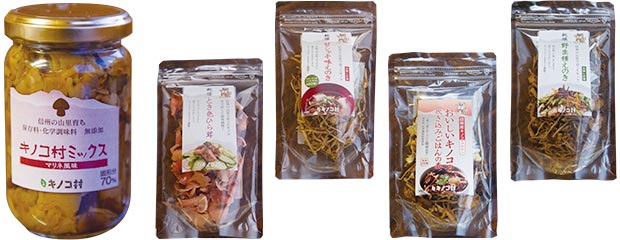
Various processed products Ginza NAGANO Now on sale!
It is processed immediately in a fresh state, making it a product without compromising its deliciousness or nutrition. All kinds of dried mushrooms are soaked in water that can be soaked in mushrooms for about 20 minutes, then softened and then used in cooking, and "dried sweet and crispy enoki" and "dried wild seed enoki" do not need to be rehydrated. Additionally, "Dried Sweet Crispy Enoki" can be enjoyed in a frying pan, heated, seasoned, and then eaten as a snack.
Successfully cultivated the "phantom mushrooms"! Nagano Copleine spreads from
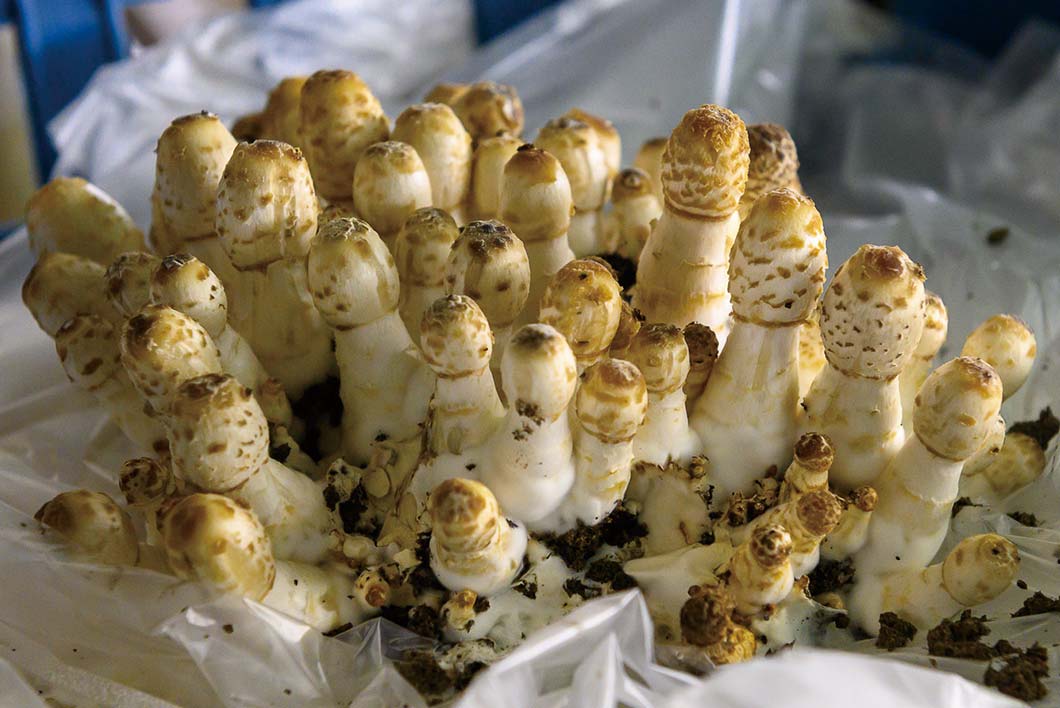
Shimada Agricultural Association(Nagano City)
Copleine is a high-class mushroom in Europe. These beautiful, white mushrooms are shaped like tsukushi, and have a unique, chewy texture and strong flavor, making them a singular taste that goes well with any dish. It is distributed almost all over the world, and in Japan it grows wild in grasslands and fields from spring to autumn, but it is difficult to grow. This is because, as the Japanese name suggests, it does not last long enough to melt after growth (overnight). For this reason, it is also called the "phantom mushroom" and there are few cultivation examples nationwide, and it is said that no one has succeeded in continuing production until now. Meanwhile, I've been doing research for about 25 years.Nagano CityShimada Hideaki, the second generation of Shimada, the agricultural cooperative corporation, succeeded in cultivating it in 2016. He is a valuable producer who continues to grow it.
"I mainly cultivated mushrooms that grow in trees and forests, such as Hiratake and Yabu Shimeji, but since Copleines originate from the soil, the cultivation method was different, and since there were no previous producers, I had no idea about cultivation theory at all. I had been groping everything and wanted to stop it many times."
At one point, even the seeds had finally been wiped out. However, without giving up, we recreated the seed bacteria using tissue culture and thoroughly reviewed the cultivation method. The nutrients of the medium were changed and the culture was carried out in a bottle, but then the medium was spread out like the ground to allow it to grow in a form close to nature. The cultivation room also uses air conditioning management in minutes to artificially create temperature differences between the day and night, promoting growth. After harvesting, the product is vacuum wrapped to prevent growth and degradation caused by oxygen, and is shipped with a beautiful shape. This is what is known now as a person who meets the special needs of specialty stores, and there are even restaurants that say that they can't operate without Copleine.
"However, it is still not very well known. So, I would be happy if you could first learn from the unique mushroom that looks good, has a good texture and is interesting."
No matter how difficult the situation is, Shimada never gave up and faced Copleine sincerely, paving the path without manual. We can't take our eyes off the future developments of rare mushrooms that are not available in the market.
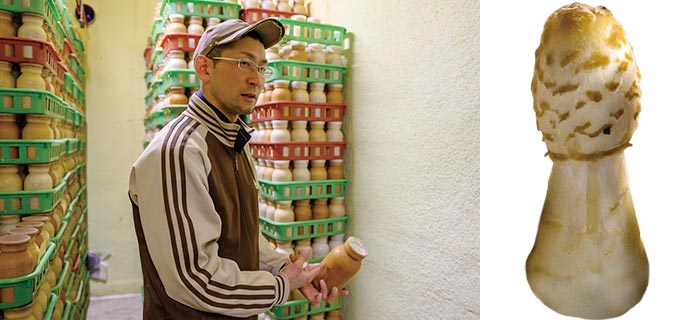
Shimada took over cultivation from his previous generation and after many twists and turns, he succeeded in commercializing it. The product name "Coprinus" was also named by Shimada after the scientific name "Coprinus comatus."
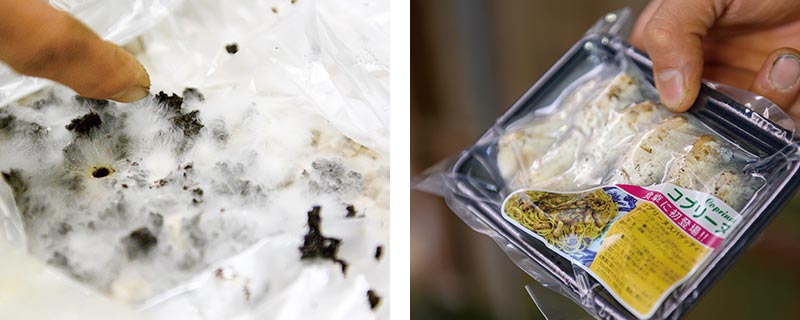
Once the mycelium spreads within the bottle, spread the medium and cultivate it. When copleine grows to about 12-25cm, its umbrella has a fluffy texture, a crisp shaft, and a crunchy root, but in this condition it is not easy to store, so it is harvested to the size of a little finger and is commercialized.
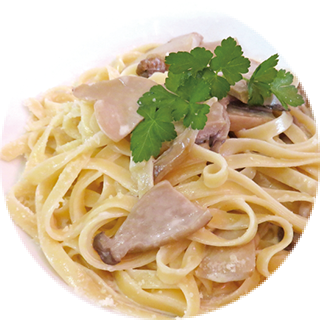
How to eat copleines
Copleines harvested in a young state have a hard and strong fiber, so they have a crunchy texture, resembling mushrooms, but have a deeper and richer feel. As with mushrooms, we recommend using stewed dishes with a strong flavor. It goes well with stewed tomatoes, rich creamy stews, stews, curry, and more. It is also served as exquisite mushroom pasta at restaurants. For Japanese cuisine, we recommend cooking such as rice cooked in rice so that the delicious flavor of the ingredients is slowly seeped out.
[Shimada Agricultural Association Corporation]
Nagano City171 Otsuka, Aokishima-cho TEL 026-286-2766
INFORMATION
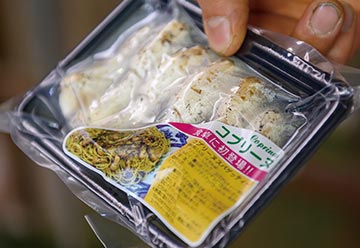
Ginza NAGANO Available for a limited time only.
This article is information as of July 2020.
Please note that the products we carry may have changed.















